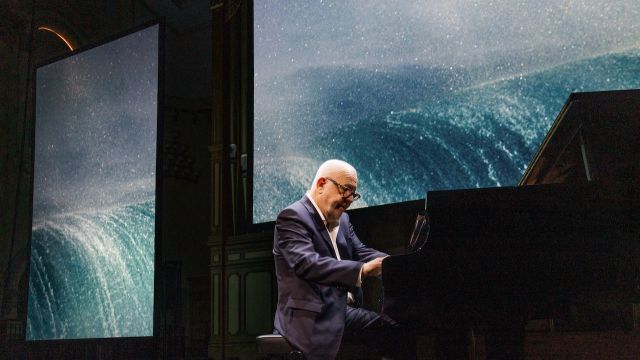Music For Other Worlds
Greg Mackie OAM, CEO of History Trust of South Australia, introduced the concert and gave an Acknowledgement of Country. He reminded us that the one night Music For Other Worlds concert could never be replicated and framed that idea by a Yehudi Menuhin quote: “Improvisation is the expression of the accumulated yearnings, dreams, and wisdom of the soul.” Rosemary Wanganeen (Kaurna and Wirringu) then entered to give a moving Welcome to Country, teaching us the correct responses. When Ms Wanganeen asked “Niina marni?” (“Are you all well?”) the packed Town Hall Audience responded “Marney - ard - lu” (We’re all well or fantastic or deadly!)
The lights dimmed on the grand piano and three rear projection screens suspended just behind: the centre screen in landscape format and bookended by two portrait-oriented screens. As virtuoso keyboardist Paul Grabowsky AO sat at the piano, the first images appeared. Alex Frayne is an Adelaide-based photographer of immense talent and sensitivity and I have admired his work for many years. The images were of immense, serene Moreton Bay Figs shrouded in mist, the indirect, soft light caressing the undulant roots. Grabowsky paused a moment taking in Frayne’s photographs then commenced their improvisation until the lights dimmed again to signify a transition. It was an ethereal beginning and worth noting that the musician was responding aurally and in the moment as they saw the images for the first time.

The next images were of three different crucifixes, the lines of the horizontals all angled differently. As inspiration stirred and the music flowed, the centre photograph zoomed out incrementally to reveal an old country church building and the surrounding bush. Grabowsky based this segment on a recognisable tune. It was possibly “Tis The Gift To Be Simple” (Joseph Brackett) but the title unfortunately eluded me. The third movement commenced with images of harsh sun, desert haze, dried out pasture land and Grabowsky plucking the strings across the soundboard of the piano, as well as some sparse, sometimes atonal keyboard play. The final image, only projected on the centre screen, was of the milky way in the night sky. A different ‘infinity’ to the sun-blasted landscapes but certainly akin to the uplifting experience this concert provided.
The fourth section showed grainy black and white, impressionistic images. Eventually, after slowly zooming out, the centre image was revealed to be a figure joyously languishing on a tyre swing in front of a building. The two lateral screens pictured shadow details from the centre photograph. The piano music here was almost continuous and light, rhythmic and flowing. A montage of images followed picturing faded country motel and fuel signs, roadkill, then roads meandering into the distance. The road surfaces were asphalt or dirt, gravel or sand, wet or dry, and the vistas coloured, washed out, black and white, or verdant. The central photograph finally settling on what looked like a grey ribbon, possibly a Kangaroo Island road undulating toward the coast. Against this image Grabowsky played fortissimo and rhythmic jazz melodies and runs, reminiscent perhaps of a road trip soundtrack.

The sixth set of photographs showed ghostly, skeletal gums rising from waterways, reflections, and idyllic creek scenes with immense trees shot in different lights, a little like a Namatjira location. The music began sparingly echoing the bleached ‘bones’ of the river as we noticed the branches of those trees reaching skyward or toward each other, in spooky family groups under a brooding sky.
Lastly was a series of jetty images and blue water with bright skies and lonely beach scenes, finally settling on three images with one lone bather in each. Like the crucifixes from earlier, the lines of the ripples ran in different directions on each photograph and Grabowsky’s sweeping, full keyboard arpeggios captured the movement of water and the joy of beach-going. The two lateral screens showed women standing in the sea with their backs to the camera, the middle pictured a seated figure on sand amidst a wash of water left by the tide. As the concert came to its conclusion and the music wound down, the zoom was inward on the images, toward the bathers. Many images came to mind of humans in nature and how we can be either careless or carefree.
Music For Other Worlds was a truly Festival-worthy: inspiring, inventive, and enthralling. It felt luxurious to sit surrounded by Frayne’s art writ large on screen while immersed in another artist’s inventive musical response. Bravo all involved in this commission, originally programmed for Illuminate Adelaide 2021 but delayed by Covid.
Lisa Lanzi
Photographer: Tony Lewis
Subscribe to our E-Newsletter, buy our latest print edition or find a Performing Arts book at Book Nook.

